Abstract
In this article, we highlight the superior performance of an aqueous high-performance sample introduction system (HP-SIS) from Glass Expansion, compared to a standard aqueous sample introduction system (SIS), using the Thermo Scientific™ PRO Duo ICP-OES.
Introduction
The goal of Glass Expansion’s HP-SIS series is to help your ICP laboratory make the right choice to achieve the best results and reduce both operating costs and downtime. In Part II of our HP-SIS series, we tackle how to achieve higher performance with your routine aqueous samples. When selecting our Aqueous HP-SIS, we shift our focus to obtaining the best possible sensitivity, precision, and detection limits, as we are no longer concerned with the challenges associated with sample matrices containing hydrofluoric acid (HF)1, volatile organic solvents, particulates, or high total dissolved solids (TDS).
Nebulizer Selection
The nebulizer is a critical choice, as the quality of the aerosol produced relates directly to the analytical performance of your ICP. The smaller the overall mean diameter of the aerosol, the better the sensitivity you will achieve, and with a narrower size distribution, the better detection limits and precision (RSD) you will have. Glass Expansion offers the largest range of concentric nebulizer designs by any manufacturer, with each model having a variety of applications for which it is ideally suited. In a 2019 report2, Glass Expansion evaluated all of its ICP-OES nebulizer models, with the SeaSpray™ Direct Connect (DC) nebulizer providing the best overall precision, sensitivity, and detection limits. Due to its well-rounded overall performance and excellent sensitivity, we chose Glass Expansion’s trademark SeaSpray™ DC nebulizer for our Aqueous HP-SIS.
The unique and proprietary design features of the SeaSpray™ DC nebulizer are shown in Figure 1. Glass Expansion’s SeaSpray™ DC nebulizer is made from borosilicate glass, featuring our patented VitriCone™ sample capillary. The VitriCone™ sample capillary is entirely different from those of other manufacturers, which use a hand-drawn glass sample capillary that is not only fragile and easily broken, but often results in poor precision because it can vibrate from the high-speed carrier gas. In comparison, the VitriCone™ is machined from a thick-walled glass capillary, providing a highly reproducible geometry and constant internal diameter – from sample inlet to tip. The DC gas line provides an inert, metal-free, instrument-specific gas line. In addition to a reliable ratchet fitting to ensure a leak-free gas connection between the nebulizer and ICP, the DC fitting assists in maintaining optimal backpressure for consistent day-to-day nebulizer performance. The UniFit™ sample connector easily slides over the sample arm of the nebulizer, creating an excellent seal and a zero-dead-volume connection. The SeaSpray™ DC nebulizer also features a uniquely engineered self-washing tip with smooth surfaces to avoid build-up of salt crystals. In addition to providing outstanding nebulization efficiency, the SeaSpray™ DC nebulizer can also tolerate up to 20% TDS.
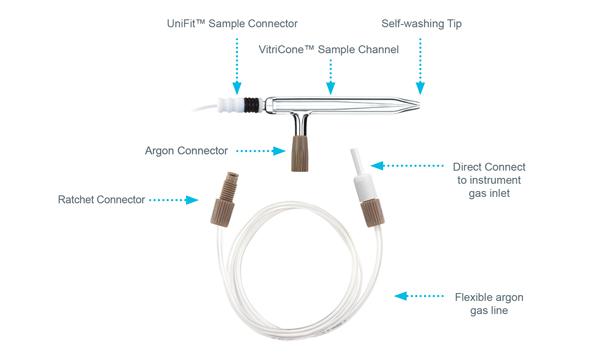
Spray Chamber Selection
The role of the spray chamber is to filter the aerosol to an appropriate size to prevent saturation of the plasma. Larger droplets can lead to poor analytical performance (sensitivity and precision), and in worse cases, will extinguish the plasma. The design and features of the spray chamber can also affect washout efficiency. The longer it takes to wash out a sample, the less efficient your testing laboratory is, resulting in a reduced profit. We chose Glass Expansion’s industry-leading Tracey™ cyclonic spray chamber for our Aqueous HP-SIS because it provides the best sensitivity, lowest detection limits, and fastest washout efficiency for standard ICP analyses.2
The Tracey™ cyclonic spray chamber is a single-pass design (50 mL volume), manufactured from high-quality borosilicate glass. For routine aqueous samples, we want to maximize the efficiency of sample transport and washout and, with no HF present, we can use a glass spray chamber. The design features of Glass Expansion’s Tracey™ cyclonic spray chamber are shown in Figure 2. An indented groove is built into the top of the spray chamber and serves as a barrier, preventing the solution from being swept into the torch. The position and depth of this groove are critical.
The proprietary Helix™ CT fitting is carefully designed to fix the depth of penetration and torque of the nebulizer seal so that the aerosol produced is optimal. The Helix™ interface is also the only true zero-dead volume nebulizer-spray chamber interface, providing unmatched washout efficiencies, as there are no “dead zones” where samples can get trapped. At the base of the spray chamber is the drain and UniFit™ connector, providing smooth and efficient draining. The walls of the chamber have a vertical region; the height of this wall is important for proper aerosol generation and optimum transport efficiency.
In a 2018 report3, Glass Expansion studied how the torque applied to the nebulizer seal and depth of the nebulizer within the spray chamber affect sensitivity. Glass Expansion’s new Helix™ CT design maintains the correct and optimum nebulizer depth within the spray chamber, so that both ion and atom lines give optimum sensitivities under a wide range of experimental conditions. It was also found that, as the torque applied to the glass nebulizer seal increases, the sensitivity decreases on average by 5%, with the greatest difference being 10% (Figure 3). The Helix™ CT locking screw is set to the optimum torque and will seal the PressFit PTFE ferrule against the nebulizer to the same torque each day, minimizing any variation in signal intensity. By pairing the SeaSpray™ DC nebulizer with the Tracey™ with Helix™ CT, you are achieving optimum sensitivity and consistent results with your Aqueous HP-SIS.
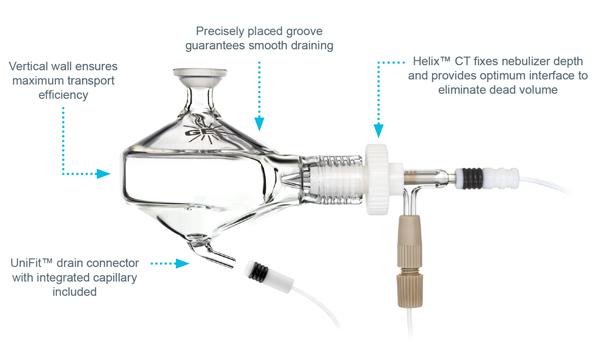
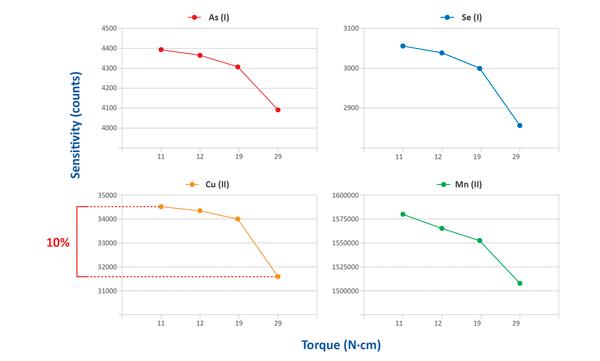
Torch Selection
For our Aqueous HP-SIS torch, we selected Glass Expansion’s patented D-Torch™ (Figure 4), a precision-engineered demountable torch. Compared to other torch designs, the D-Torch™ is the only design with a ceramic intermediate tube and demountable ceramic outer tube. With the goal of pushing detection limits and sensitivity, the D-Torch™ with a ceramic outer tube was chosen because it produces a hotter and more robust plasma. In a 2020 study, Glass Expansion showed that the combination of the Tracey™ with Helix™ CT spray chamber and fully ceramic D-Torch™ provided a 30% to 40% improvement in detection limits on the standard SIS.4
Compared to a quartz outer tube, the ceramic outer tube also has a much longer lifetime, greatly reducing maintenance and downtime due to torch failure. These features will attribute to significant cost savings.
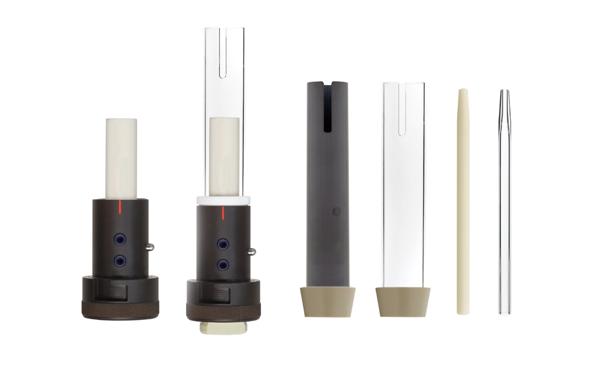
Cost and Quality
In addition to the analytical performance requirements, your ICP laboratory would also consider the cost and quality of the SIS. It is important to evaluate the hidden costs associated with poor-quality SIS components, such as frequency of replacement, opportunity cost due to instrument downtime, and the time required to reoptimize your instrument parameters. The reproducibility, quality, and dependability provide ICP laboratories with significant long-term cost savings, which are the goals of Glass Expansion’s sample introduction components.
Glass Expansion’s products are designed to last longer and provide optimum performance. And when a replacement is needed, there is no time wasted re-optimizing due to Glass Expansion’s unique and proprietary manufacturing methods, which enable the production of components with the highest mechanical accuracy and precision.
Our commitment to research and product development, which includes owning ICP-OES and ICP-MS instruments from several manufacturers, enables us to produce innovative design solutions and conduct real-world testing that leads to the best possible performance, consistency, and reliability for your laboratory.
Experimental
The Glass Expansion Aqueous HP-SIS configuration consisted of the SeaSpray™ DC nebulizer (P/N A31-07-USS2), plus the Tracey™ with Helix™ CT spray chamber (P/N 20-809-2665HE), and fully ceramic D-Torch™ (P/N 30-808-4150 and 31-808-3996) with a 2.0mm ID quartz injector (P/N 31-808-2836). An evaluation of the relative sensitivity and relative signal-to-root background ratio (SRBR) was used to compare the performance of Glass Expansion’s Aqueous HP-SIS to the standard Aqueous SIS.
All experiments were conducted under identical conditions using a Thermo Scientific™ PRO Duo ICP-OES. Instrumental conditions are listed in Table 1. Two solutions were prepared: a 2% HNO3
blank and multi-element standard in 2% HNO3 consisting of 10ppm As and Se; and 5ppm Cu, K, Mg, Mn, Na and Ni.
| Name | Set Value |
| RF Power | 1200 W |
| Nebulizer gas flow rate | 0.70 L/min |
| Auxiliary gas flow rate | 1.00 L/min |
| Plasma gas flow rate | 12.0 L/min |
| Read time | 30 sec |
| Replicates | 3 |
| Viewing mode | Axial |
| Sample pump tubing | 0.64mm ID (Orange/White) P/N: 0.64-OW-F |
| Drain pump tubing | 1.02mm ID (White/White) P/N: 1.02-WHT-F |
| Peristaltic pump speed | 45 rpm |
Results
Figure 5 depicts the sensitivity of the standard SIS relative to Glass Expansion Aqueous HP-SIS (relative sensitivity = 1). Based on the configuration and experimental conditions above, the relative sensitivity is improved by an average of 30% using Glass Expansion’s HP-SIS combination of the SeaSpray™ DC nebulizer, Tracey™ spray chamber, and fully ceramic D-Torch™.
The best indicator of analytical detectability for ICP-OES using a solid-state detector is the SRBR. Similar to what was observed when comparing sensitivity, the SeaSpray™ DC nebulizer, Tracey™ spray chamber, and fully ceramic D-Torch™ provide a 25% average improvement in SRBR over the standard Aqueous SIS (Figure 6).
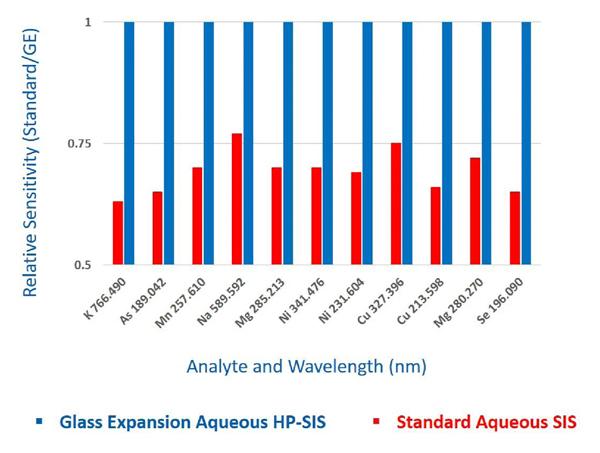

Conclusion
The components of your ICP’s sample introduction system are critical, determining many factors, including detection limits, precision, different matrix tolerances, cost, and effective run time. The results presented in this report indicate that sensitivity and SRBR are both improved by an average of 30% and 25%, respectively, with the Glass Expansion Aqueous HP-SIS. The combination of the SeaSpray™, Tracey™ with Helix™ CT, and fully ceramic D-Torch™ is the superior aqueous sample introduction configuration compared to the standard Aqueous SIS. Glass Expansion’s innovative designs, such as the VitriCone™ sample capillary, DC gas line, Helix™ CT, and patented fully ceramic D-Torch™ provide the ICP laboratory with significant long-term cost savings due to the reliability, consistent performance, and longer lifetime.
References
- Glass Expansion, September 2022, A Dedicated HF-Resistant, High-Performance Sample Intro System (HP-SIS) for ICP-OES.
- Glass Expansion Newsletter, May 2019, A Guide to Choosing Nebulizers and Spray Chambers for your ICP-OES.
- Glass Expansion Newsletter, February 2018, Helix CT ICP Spray Chamber with ConstantTorque Technology Provides Consistent Day-to-Day Analytical Performance.
- Glass Expansion Newsletter, August 2020, A High-Performance Sample Introduction System for the Agilent ® 5000 Series ICP-OES.

